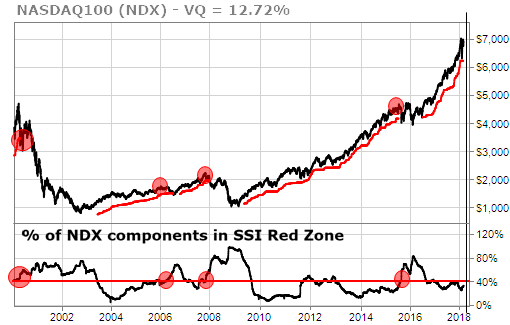Last week we ran our proprietary analysis on the Dow Jones Industrial Average (DJIA) and noted some serious red flags that could signal trouble ahead. The DJIA itself is in the Red Zone and more than 40% of the component stocks in the DJIA are also in the Red Zone.
When both of these conditions were met in the past, we found that the average additional decline in the DJIA was another 27%. Both of these conditions were recently triggered in the DJIA again in late February.
Given the importance of tech companies today… we decided to run a similar multi-decade analysis on the Nasdaq 100. The results were interesting to say the least.
There is perhaps more emphasis on technology companies today – think Amazon, Apple, Google, and Facebook, along with Netflix, Microsoft, Salesforce.com, and others – than at any other point since the year 2000.
The investor emphasis on technology today is also far more sustainable than it was in 2000. That is because while many “dot coms” never earned a penny back then, today’s tech giants are highly profitable.
So… what did we find? Well, I’ve got good news and bad news. Let’s take the bad news first.
The bad news is that when we do get these 2 “Red Zone” signals simultaneously in the Nasdaq 100, the potential downside consequences can be absolutely disastrous. The table below shows how much further the Nasdaq 100 fell after both Red Zone signals were triggered.
| Symbol | 40% Stop Out Date | SSI Stop Out Date | Maximum Decline |
|---|---|---|---|
| NDX | 1/3/2000 | 4/14/2000 | -78.77% |
| NDX | 4/5/2006 | 7/12/2006 | -16.50% |
| NDX | 11/6/2007 | 1/7/2008 | -54.19% |
| NDX | 8/12/2015 | 8/24/2015 | -16.40% |
| Average: | -41.47% | ||
When the Nasdaq 100 goes dual Red Zone on us, it can get ugly quick. The chart below shows the 4 times in the past when both Red Zone signals triggered at the same time.

Now for the good news. The Nasdaq 100 index, as of this writing, has not triggered an SSI red zone signal nor have 40% of the component stocks of the Nasdaq 100 reached the Red Zone. The bearish conditions we saw with the Dow are not yet in place for the Nasdaq.
Simply put, the Nasdaq is much stronger than the Dow at this time. So much stronger, in fact, that while the Dow is flashing bright red warning signs, the Nasdaq 100 is still more or less giving a thumbs up. Though it has recently come perilously close to triggering these signals, at the time of this writing, the Nasdaq 100 is actually pushing all-time highs.
Does this mean everything is fine and investors can rest easy? Not exactly. There is one last point of caution to consider here.
We mentioned that the Nasdaq is more relevant than ever today because of a handful of tech giants: The Amazons, Apples, Googles, and so on.
The last point of caution is this: When the market starts to rely on a very small number of stocks to power nearly all the gains… while the rest of the market is starting to lag and falter… that is a worrisome thing overall.
If investors are pushing Amazon, Apple, and Google to new highs day after day because they can’t find anything else to buy, that suggests the market could be running out of steam. (And some of these companies, particularly Amazon, have incredibly rich valuations.)
The divergence between the Dow and the Nasdaq 100 is something to watch. If our Dow indicators become bullish again, that will be a sign of health and resilience for the market heading into the rest of 2018. But if instead the Nasdaq 100 stumbles and starts flashing warning signs like the Dow… that will be all the more reason to take a defensive posture.





